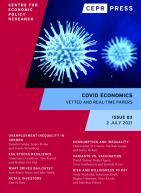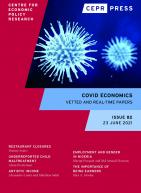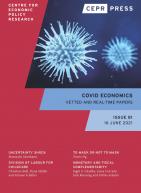
Using a large-scale survey of U.S. households during the Covid-19 pandemic, we study how new information about fiscal and monetary policy responses to the crisis affects households’ expectations. We provide random subsets of participants in the Nielsen Homescan panel with different combinations of information about the severity of the pandemic, recent actions by the Federal Reserve, stimulus measures, as well as recommendations from health officials. This experiment allows us to assess to what extent these policy announcements alter the beliefs and spending plans of households. In short, they do not, contrary to the powerful effects they have in standard macroeconomic models.
Citation
Gorodnichenko, Y, M Weber and O Coibion (2020), ‘Does policy communication during COVID work?‘, COVID Economics 29, CEPR Press, Paris & London. https://cepr.org/publications/covid-economics-issue-29#392514_392905_390514
Liquidity restrictions on investors, like the redemption gates and liquidity fees introduced in the 2016 money market fund (MMF) reform, are meant to improve financial stability during crisis. However, we find evidence that they may have exacerbated the run on prime MMFs during the Covid-19 crisis. Severe outflows from prime MMFs amid frozen short-term funding markets led the Federal Reserve to intervene with the Money Market Mutual Fund Liquidity Facility (MMLF). By providing “liquidity of last resort,†the MMLF successfully stopped the run on prime MMFs and gradually stabilized conditions in short-term funding markets.
Citation
Zhou, X, Y Li, M Macchiavelli and L LI (2020), ‘Runs and Interventions in the Time of Covid-19: Evidence from Money Funds‘, COVID Economics 29, CEPR Press, Paris & London. https://cepr.org/publications/covid-economics-issue-29#392514_392905_390515
Covid-19 induced job losses occurred predominantly in industries with intensive worker-client interaction as well as in pink-collar and blue-collar occupations. We study the ability of fiscal policy to stabilize employment by occupation and industry during the Covid-19 crisis. We use a multi-sector, multi-occupation macroeconomic model and investigate different fiscal policy instruments that help the economy recover faster. We show that fiscal stimuli foster job growth for hard-hit pink-collar workers, whereas stimulating blue-collar job creation is more challenging. A cut in labor taxes performs best in stabilizing total employment and the employment composition.
Citation
Juessen, F, R Winkler and C Bredemeier (2020), ‘Bringing back the jobs lost to Covid-19: the role of fiscal policy‘, COVID Economics 29, CEPR Press, Paris & London. https://cepr.org/publications/covid-economics-issue-29#392514_392905_390516
The COVID-19 pandemic has resulted in over 2 billion people in the world affected by lockdowns. This has significant socioeconomic implications, especially in areas such as crime, where police resources are diverted from crime prevention towards enforcing lockdowns. Also, mobility restrictions imposed by lockdowns might make it harder for criminals to find victims. The net effect of these opposite forces is unknown. This study analyzes the effect of lockdowns on criminal activity in the state of Bihar, India. A sharp regression discontinuity design is implemented harnessing the sudden introduction of a state-wide lockdown and novel high-frequency criminal case data. The results show that lockdown decreases aggregate crime by 44 percent. Negative large effects are observed in diverse types of crimes such as murder (61 percent), theft (63 percent), and crimes against women (64 percent), among others. This seems to be driven by the higher search costs faced by criminals. Finally, by exploiting geographic variation in terms of lockdowns' severity across districts, this study shows that relaxing lockdowns' initial restrictions increase crime, but the increment is lower in less restrictive lockdowns than in restrictive ones. While economically-motivated crimes increased, violent crimes were not impacted. This suggests that the economic downturn produced by the lockdown might be driving these effects. Policy recommendations are discussed.
Citation
Poblete-Cazenave, R (2020), ‘The Great Lockdown and Criminal Activity - Evidence from Bihar, India‘, COVID Economics 29, CEPR Press, Paris & London. https://cepr.org/publications/covid-economics-issue-29#392514_392905_390517
This paper develops a choice-theoretic equilibrium model of the labor market in the presence of a pandemic. It includes heterogeneity in productivity, age and the ability to work at home. Worker and firm behavior changes in the presence of the virus, which itself has equilibrium consequences for the infection rate. The model is calibrated to the UK and counterfactual lockdown measures are evaluated. We find a different response in both the evolution of the virus and the labor market with different degrees of severity of lockdown. We use these insights to make a labor market policy prescription to be used in conjunction with lockdown measures. Finally we find that, while the pandemic and ensuing policies impact the majority of the population negatively, consistent with recent studies, the costs are not borne equally. While the old face the highest health risks, it is the young low wage workers who suffer the most income and employment risk.
Citation
Ruggieri, A, A Spencer and J Bradley (2020), ‘Twin Peaks: Covid-19 and the Labor Market‘, COVID Economics 29, CEPR Press, Paris & London. https://cepr.org/publications/covid-economics-issue-29#392514_392905_390518


Covid Economics - Issue 82
- Restaurant Closures during the Pandemic: A Descriptive Analysis
- Underreporting Child Maltreatment during the Pandemic: Evidence from Colorado
- Covid-19 impact on Artistic Income
- COVID-19, Employment, and Gender: Evidence from Nigeria
- The Importance of Being Earners: Modelling the Implications of Changes to Welfare Contributions on Macroeconomic Recovery
